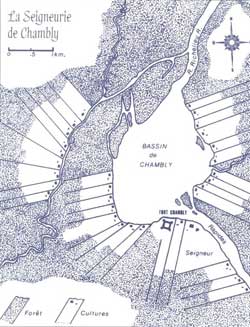
Land concessions based on the seigneurial system
Fort Chambly National Historic Site

Land allocation under the seigneurial system
© Parks Canada
If you can get a bird’s-eye view of the Richelieu Valley, it is hard not to notice the image patterns formed by the farmland bordering the river. The rectangular shape of these plots and their arrangement perpendicular to the Richelieu, intended to provide river access for the greatest number of people, shows how land was attributed at the time of New France. Under the rule of Louis XIII and his minister, Cardinal Richelieu, the seigneurial system, already long established in France, was adopted to develop and populate this colony in America. The system came into effect in 1627, and the Company of One Hundred Associates was given responsibility for handing out the seigneuries.
The seigneurial system was also a land distribution system aimed at populating the colony and regulating society. The territory to be developed was divided into seigneuries, which were granted to figures who had provided service to the king. Jacques de Chambly, an officer in the Carignan-Salières regiment, received the territory occupied today by the municipalities of Chambly, Carignan, Richelieu, Saint-Mathias-sur-Richelieu and Saint-Basile-le-Grand.
The seigneur and the habitants to whom he conceded land had rights and responsibilities. The seigneur had to have a manor house built on the seigneurie and to live in it. He was also responsible for building and maintaining a wheat mill. The habitants, for their part, had to pay the seigneur taxes called "cens" – giving rise to the term "censitaire" applied to them – and rent, in money or farm products. Each year they were also required to put in several days of work, known as “corvées”, for the seigneur.
The seigneurial system was abolished in 1854, but its influence on rural Quebec’s way of life would last several decades longer.
Related links
- Date modified :